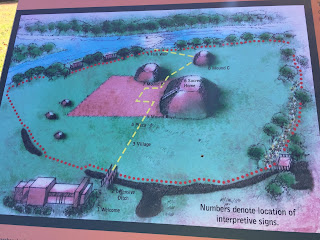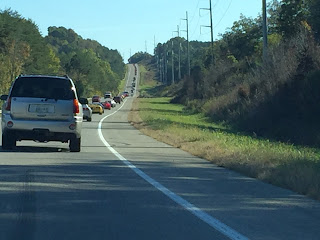October is over and I am sad. It is time to tuck our beloved RV in for the winter. This means drain the tanks and pipes of water and refill with antifreeze, so that when we are ready to head out next spring we won't find water trickling down the walls in some unexpected places. Before October faded into the past, we squeezed one last trip in to a very busy couple of weeks. We headed to Lake Allatoona Marina Campground in Cartersville, Ga. for three days.
And of course, we had a chance to add to our list of adventures.
First rule, reconfirmed. DO NOT put the address of the campsite in your GPS from memory. There will probably be a major routing difference between Chestnut Street, Chestnut Drive, Chestnut Landing or Chestnut Avenue. We, of course, did put the address in from memory and after driving through narrow, busy downtown streets searching for our lakefront campsite, we finally decided to check it. OOPS. Note to self: RVs with Toads do not make U-Turns. Country roads do not have 6 lane turn-arounds. And we don't back up! Double check the address before leaving!!
Rule No. 2: Follow the directions in the RV Camping Directory when it tells you what exit to take off of the interstate. My always adventurous husband decided to leave I-75 at exit 290 instead of exit 283 because, "that road should take us down there, shouldn't it?" Um hmm. Perhaps that is also why we were winding our way through narrow, busy downtown streets. Not all roads are RV friendly. Your favorite RV directory probably knows better! Refer to the consequences stated in Rule No. 1.
We managed to make it to the campsite in tact, and settled into our site. Before long we heard the sound of an approaching train. The train blew its whistle--3 short, 1 long (very long) blasts as it neared a crossing, and then rumbled past the campground.
As we sat at the picnic table, we eyed the train passing through the trees. Larry said, "They missed this part in the campground description." We both thought back to the tracks we had crossed over as we came into the campground.
 |
Fence=edge of campground. Trees=non-soundproofed barrier by train track. |
"I wonder if they observe quiet hours?" I said.
The next morning we pulled ourselves out of bed, and said, "Nope. They don't observe quiet hours." I counted 12 trains that went by during the night.
In spite of the trains that frequently went by, we enjoyed our stay at the lake, and exploring nearby Cartersville. Cartersville turned out to be a really nice town with some interesting places to check out.
The Welcome Center was a good place to start, and the woman we spoke with gave us some good ideas of places to eat lunch. The variety of choices covered a real diner with counter seating only, Pizza at the Mellow Mushroom, Swheat Market for healthy offerings, wings and oysters (an interesting combination) at Jefferson's as well as atmosphere at some other downtown establishments. We settled for Monte Cristo's at the Appalachian Grill. I ate almost the whole thing and then swore off all food for the next 3 days to counteract the calories I had just consumed. But boy, was it good!
Walking around town I found a great variety of shops to peruse. Larry found plenty of benches from which to observe the world.
I discovered a map of the area drawn in concrete, that explained the importance of trains to the area. Cartersville is located at a spot in the mountains where the ridges are easiest to cross. The trains come from north, south, east and west and converge to cross the Etowah river. While there was a single track by our campground, trains went by there in both directions meaning there were double tracks that came to a single track at that point.
Notice where the track crosses the water? Draw an RV next to the track. Add 2 sleepy people by the RV.
This was also a main battle and defense area during the civil war when the North held control of the train track. Today, transportation by train seems to be alive and well in that region.
Notice where the track crosses the water? Draw an RV next to the track. Add 2 sleepy people by the RV.
This was also a main battle and defense area during the civil war when the North held control of the train track. Today, transportation by train seems to be alive and well in that region.

As we walked past Young Brothers Pharmacy the displays in the window drew us inside. It quickly became my favorite spot downtown.
The first thing I noticed was the great Coca-Cola wall outside. (more about this in a moment) Walking inside I was instantly transported back to my childhood. This was a true pharmacy, not the typical drugstore/mini mart of today.
 |
I love the checkerboard floor and the simple low shelving |
It all became clear when Larry came across a scrapbook near the front door. Apparently the owner of the drugstore had heard tales that under coats of paint on an outside wall was an original painting advertising Coca Cola. In researching the rumors he discovered that back in 1894, Coca Cola Salesman, James Coudon, made the offer that any store selling Coca Cola could have their wall painted with the advertisement for free. Then he proceeded to paint the sign. This store was the first one ever to get the Wall sign! In 1989, the owner, Dean Cox commissioned some restorers to find the sign. The article detailing the work was fascinating. And sure enough, 25 coats of paint down, there was the original sign.
There is plenty of history to peruse in Cartersville. The Bartow County Museum and the Booth Western Art Museum affiliated with the Smithsonian Institute came well recommended. There were great reviews of the Rose Lawn Museum which is actually an old house.. I would enjoy visiting these places but we ran out of time. Something to do if we go back!


I did get a chance to visit the Etowah Indian Mounds and the Etowah Archaeological Museum.
The day I went turned out to be School Day, and the parking lot was packed with buses and cars. The advantage was that I was able to tag along with some class groups and hear some narration by the park rangers. However, watching the video was pointless as the teachers used that room as a roundup and transition place for groups.
The day I went turned out to be School Day, and the parking lot was packed with buses and cars. The advantage was that I was able to tag along with some class groups and hear some narration by the park rangers. However, watching the video was pointless as the teachers used that room as a roundup and transition place for groups.
 |
| Map of the village on the banks of the Etowah River. A mock up of the village in the museum shows the placement of the celebration plaza, villagers huts and fields where crops were grown. |
I originally thought the mounds were referring to Burial mounds, but that wasn't the case. This was a community. The Chief lived on the highest mound and conducted business from there. The lowest mound was, indeed, a burial mound.
There were two paths visitors could take so with all the kids on the main field, I chose the perimeter path which took me by the river and brought me to the back of the mounds.
Lots of steps led up to the top of the mounds. The school kids had made the climb to the top of the highest mound. I eyed those steps and promptly headed to the lowest mound. I climbed those steps and declared that sufficient to assuage my curiosity. It was a mound. It is a mound. Big hill. Lots of steps. Lots of grass. No chief living there now. All still safely buried.
There were two paths visitors could take so with all the kids on the main field, I chose the perimeter path which took me by the river and brought me to the back of the mounds.
The area was well marked with plaques explaining how things were done. This hut under construction demonstrated how they built their homes and covered them with Georgia clay. These were not nomadic people. This was a permanent community of several thousand people who lived here over 600 years, in the years before the European explorers arrived. By 1550 they had moved away.
Perhaps the most interesting tidbit I picked up was how the Indians farmed. They planted their three main crops--corn, beans, and squash--together. The corn grew tall and provided a pole for the beans to climb. The beans produced nitrogen and returned nutrients to the soil that the corn needed. The squash grew along the corn and the large leaves provided shade on the ground helping to keep the moisture in. How clever! It shows how effective companion crops can be.
One last site I visited was the Allatoona Battlefield located just outside our campground. Soldiers from five northern states and six southern states fought there in an effort to secure control of the railway system through the pass. Signs detailing the importance of this place during the civil war told of a bloody battle to win control of the train track. Both the northern states and the southern states placed granite stones recognizing the units involved. This memorial is arranged in a semi-circle at the site of the old railway track to commemorate this battle.
Today the track has been relocated and widened a few yards away. The old track is now a foot path open to the public.
All in all, our last trip was a good one. We managed to sleep through most of the trains by the last night. At least we didn't hear as many. The campground itself was a very nice one and the lake was beautiful.
Frog's final trip of the season was a good, but it was time to head home. The hummingbirds have flown south. The leaves have fallen. It is time to let Frog hibernate through winter.
(If you've forgotten my reference to the RV as Frog, refer to my post a year ago on 10/25/14.)

























































